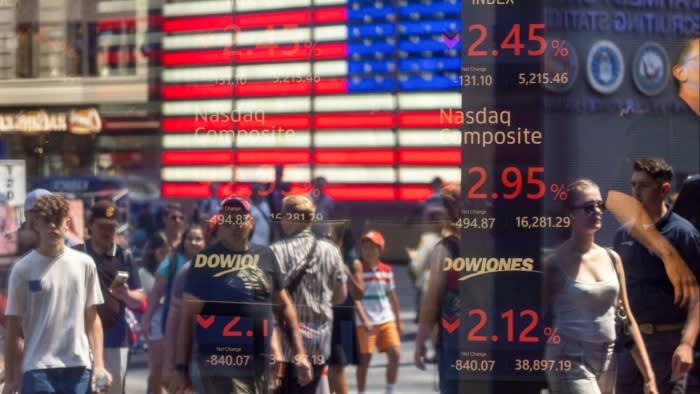Unlock the Editor’s Digest for free
Roula Khalaf, Editor of the FT, selects her favourite stories in this weekly newsletter.
What rout? Wall Street this week erased all of the losses from its nightmare start to August, cueing jokes about summertime truly being better spent at the beach than following market dramas too closely. Yet even during the sell-off there was one group who held their nerve, whether sporting sunglasses or their screen-reading specs, and those were retail investors.
Mom-and-pop traders are usually thought of as the last to join an investing bandwagon, meaning they should be the first to freak out when, having bought near the top, their profits are threatened by any market wobble. As smaller investors have become a greater share of daily trading in recent years, encouraged by online-focused platforms such as Robinhood and Interactive Brokers, their behaviour matters more for the wider market, too.
So should their recent resolve be considered an example of steeliness, or a risky confidence that pays off only up to the point where it goes wrong?
A quick refresher: Shares slid heavily on the first two trading days of August, sparking a panic that wiped 12 per cent off Tokyo’s benchmark index when trading resumed on the Monday. That triggered yet more selling in New York, taking the S&P 500’s losses at their worst to more than 7 per cent in just three days. Markets have mostly moved higher since, although unevenly.
Yet even during the depths of the sell-off, small investors were undaunted, it seems.
“Our customers were buying before the market fell. They bought while it fell and they’re buying now it’s going back up,” said Steve Sosnick, chief market strategist at Interactive Brokers. “They have not had their faith shaken whatsoever.”
Data this week from investor flow specialists Vanda Research showed mom-and-pop inflows into US stocks this month surged to their highest levels in more than a year and even after subsiding slightly in recent days, are still near those peaks.
“We’ve rarely seen retail buck historical trends so abruptly, especially in the second half of the year,” said Vanda Research’s Marco Iachini. Typically, retail investors put the most into stocks in January, and the pace of net inflows eases more or less steadily from there.
There’s potentially an element of catch-up after months of subdued inflows from small traders. But Robinhood customers ploughed more money into buying shares on the Monday when the falls were at their deepest than on any other trading session so far this year, according to chief brokerage officer Steve Quirk.
“If a retail investor had wanted to buy Apple or a broad-based ETF at an attractive level, the market just gave them a wonderful opportunity and they took advantage,” he said.
Apple fell almost 5 per cent on that Monday and, at its lowest, was down 17 per cent from its peak three weeks previously. Chipmaker Nvidia, another favourite with small investors, was off 31 per cent over the same period.
There’s an argument, too, that changing behaviour among retail investors could be boosting a buy-the-dip mentality, notably as a result of fractional share trading. This allow traders to invest amounts smaller than the price of a share, enabling savings-like regular investing. Without that, a would-be shareholder of limited means might have to wait until they can pay $400-$500 for a single share in, say, Microsoft or Facebook owner Meta Platforms.
“Our clients look at historical precedents and say, ‘sure, I might see some volatility over the course of my 25-year investing career, but if I’m buying these in the long run, there’s no way that this isn’t going to be advantageous’,” said Quirk.
If buying-the-dips is also buy-and-hold, that’s all to the good of the markets, and likely for the returns for those shareholders too.
But it doesn’t remove one big risk — and that’s that small investors, even more than large ones, seem to have been doubling down on the same top technology names as before.
VandaTrack’s Iachini noted the biggest flows were into popular tech names while Nvidia and Tesla topped trading at Interactive Brokers, followed by a risky exchange traded fund designed to boost short-term chip stock gains via leverage.
“It’s working for them, I can’t argue with that,” said Interactive’s Sosnick. “My concern is that they’ve been rewarded for following the first part of Warren Buffett’s mantra about being greedy when others are fearful but they might not be so much following the second part about being fearful when people are greedy.”
This summer’s rout was brief and has so far avoided spiralling into anything worse. Investors of any size might not be so lucky next time their nerves are tested.




